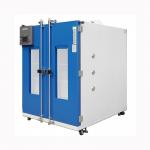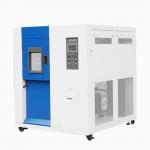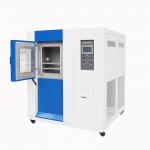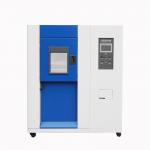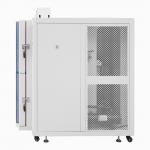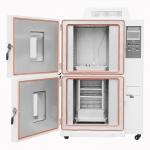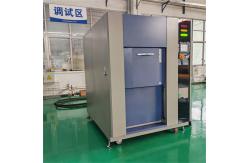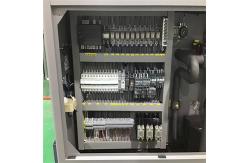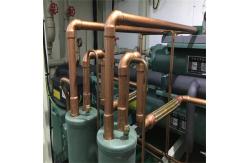In the aerospace industry, where the margin for error is
infinitesimal and the demands for reliability are astronomical,
Thermal Shock Test Chambers stand as sentinels of quality and
durability. These chambers are meticulously designed to subject
aerospace components and materials to the harshest and most extreme
temperature differentials, simulating the unforgiving environments
they will encounter both on Earth and in the vastness of space. Thermal Shock Test Chambers for the Aerospace Industry are
engineered to evaluate the integrity and performance of a wide
array of aerospace-related items. From delicate avionics systems
and precision-engineered turbine blades to the robust materials
used in spacecraft construction, these chambers replicate the rapid
and severe temperature changes that occur during launch, re-entry,
and operation in the vacuum of space or at high altitudes. The
primary objective is to identify any potential weaknesses or
failures in materials and components due to thermal stress, thereby
ensuring that every part of an aerospace vehicle can withstand the
rigors of its mission and safeguard the lives of astronauts and the
success of space exploration and aviation endeavors. - Ultra-Robust and Space-Grade Insulated Chamber Design
- Constructed with aerospace-grade alloys and advanced composites,
the chamber is built to endure the most punishing conditions. The
exterior is highly resistant to corrosion, impact, and radiation,
safeguarding the internal mechanisms and the samples under test.
The interior is lined with a specialized non-reactive and
low-outgassing surface, crucial for preventing any contamination of
sensitive aerospace components. The insulation is a marvel of
engineering, consisting of multiple layers of high-performance
materials that can withstand extreme temperature gradients and
maintain an airtight and thermally stable environment.
- The door of the chamber is a feat of precision engineering. It
features a hermetic sealing mechanism that can withstand the
pressure differentials associated with rapid temperature changes.
Equipped with a redundant locking system and a heavy-duty hinge, it
allows for secure and easy access. The door also incorporates a
large, optically clear, and radiation-resistant viewing window,
enabling engineers to closely monitor the testing process without
compromising the integrity of the internal environment.
- Precision Temperature Control Systems of Unparalleled Accuracy
- The temperature control system is a technological tour de force.
Capable of spanning a staggering temperature range from -200°C to
+2000°C, it can replicate the frigid cold of deep space and the
intense heat of re-entry. The system employs a combination of
state-of-the-art heating and refrigeration technologies, including
cryogenic cooling and high-intensity heating elements. With a
feedback loop that incorporates ultra-sensitive temperature sensors
placed with micron-level precision throughout the chamber, it
achieves temperature accuracy within ±0.1°C. This level of
precision is essential for detecting the most minute changes in
material properties and component performance under thermal stress.
- The temperature uniformity within the chamber is maintained within
an astonishing ±0.2°C, ensuring that every atom of the tested
aerospace component experiences an identical thermal environment.
The system is also equipped with fail-safe mechanisms and redundant
controls to prevent any catastrophic temperature excursions,
protecting both the valuable samples and the chamber itself from
damage.
- Advanced Airflow and Transfer Mechanisms for Seamless Testing
- The chamber is outfitted with a highly optimized airflow system.
The airflow is precisely calibrated to achieve rapid and uniform
temperature distribution, minimizing any thermal gradients that
could skew test results. The transfer mechanism between the hot and
cold zones is a work of art in mechanical engineering. It allows
for instantaneous and smooth transfer of samples, ensuring that the
temperature change is as abrupt and accurate as possible. The
transfer device is constructed from materials with extremely low
thermal inertia, preventing any unwanted heat absorption or
dissipation during the transfer process.
- The sample holders and racks are custom-designed for each type of
aerospace component. They are fabricated from materials that can
withstand the extreme temperatures and forces involved, while also
providing a secure and stable platform for the samples. These
holders are engineered to be easily interchangeable, facilitating
efficient testing of a diverse range of components.
- Temperature Range: As mentioned, the chamber can operate from -200°C to +2000°C.
This vast range is indispensable for testing everything from the
cryogenic fuel systems of rockets to the heat shields of
spacecraft. For example, the thermal protection tiles on a space
shuttle need to endure temperatures in excess of 1000°C during
re-entry, while the electronics on a satellite may experience
temperatures as low as -200°C in the cold vacuum of space.
- Temperature Transition Rate: The chambers can achieve lightning-fast temperature transitions,
often within seconds. This rate is crucial for mimicking the rapid
temperature changes that occur during launch and re-entry. For
instance, a satellite may go from the cold temperatures of space to
the intense heat generated by its own electronics or exposure to
solar radiation in a matter of minutes, and the chamber must be
able to replicate this precisely.
- Uniformity and Stability: The temperature uniformity within the chamber is maintained
within ±0.2°C, and the stability of the temperature in each zone is
exceptional, with fluctuations of less than 0.1°C over time. This
level of precision and stability is essential for conducting
accurate and repeatable tests, ensuring that the results are
reliable and can be used to make critical decisions about aerospace
component design and performance.
- Faithful Simulation of Aerospace Thermal Extremes
- The primary function of these chambers is to recreate the exact
thermal environments that aerospace components will face. By
subjecting them to rapid and extreme temperature changes, engineers
can evaluate how materials and components will behave under the
most demanding conditions. For example, testing the thermal shock
resistance of a jet engine turbine blade can reveal any potential
cracking or deformation that could lead to catastrophic engine
failure during flight.
- The ability to program complex and highly customized temperature
profiles is a key feature. This allows for the simulation of
specific mission scenarios, such as the temperature fluctuations a
spacecraft will experience during a multi-year mission to Mars or
the thermal cycling an aircraft component will endure during
thousands of takeoffs and landings. By testing under these precise
conditions, aerospace manufacturers can ensure that their products
are optimized for their intended applications.
- Enhanced Aerospace Component Quality and Mission Success
- Through rigorous thermal shock testing, the aerospace industry can
significantly improve the quality and reliability of its
components. By identifying and addressing potential weaknesses
early in the design and manufacturing process, the risk of
in-flight failures is greatly reduced. For example, if a critical
avionics component fails thermal shock testing, engineers can
modify the design, select different materials, or improve the
manufacturing process to enhance its durability. This ultimately
leads to increased mission success rates and the safety of
astronauts and passengers.
- The test chambers also play a crucial role in the development of
new materials and technologies for the aerospace industry. By
understanding how different materials respond to thermal shock,
researchers can design and engineer next-generation materials with
improved thermal properties, such as advanced composites that are
both lightweight and highly resistant to thermal stress. This
innovation drives the industry forward, enabling the development of
more efficient and capable aerospace vehicles.
- Compliance with Stringent Aerospace Standards and Regulations
- The aerospace industry is governed by some of the most 严格的
standards and regulations in the world. Thermal Shock Test Chambers
are an essential tool for ensuring compliance. Manufacturers must
conduct tests in accordance with standards set by organizations
such as NASA, ESA, and the FAA. These tests provide the necessary
data to prove that aerospace components meet the required safety
and performance criteria. Without accurate and reliable thermal
shock testing, aerospace vehicles would not be cleared for launch
or flight, putting lives and costly missions at risk.
- Regulatory bodies rely on the precise test results obtained from
these chambers to enforce safety and quality regulations. They
serve as a means for certifying that aerospace components can
withstand the thermal stress they will encounter during their
operational lifetimes, ensuring the integrity of the aerospace
ecosystem and the safety of those who depend on it.
- Stringent Manufacturing Process of the Highest Order
- The Thermal Shock Test Chambers for the Aerospace Industry are
manufactured under the most exacting quality control procedures.
Every component, from the exotic heating and refrigeration elements
to the ultra-sensitive temperature sensors and the advanced
insulation materials, is sourced from the most reliable and
reputable suppliers. The assembly process is carried out by a team
of highly skilled and trained technicians in a cleanroom
environment with strict contamination control measures. Each step
of the assembly is meticulously documented and inspected to ensure
the proper installation and functionality of all parts.
- The calibration of the temperature sensors and control systems is a
continuous and highly precise process. It is performed using
traceable reference standards that are calibrated to international
standards of the highest accuracy. Rigorous quality audits and
inspections are conducted at multiple stages of production,
including during component assembly, system integration, and final
testing. Any deviation from the strict qualit
|
